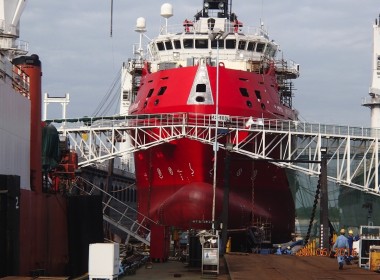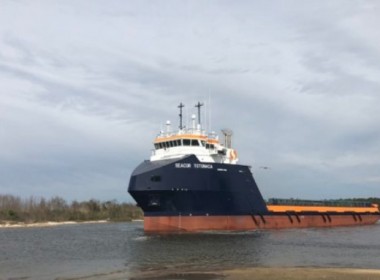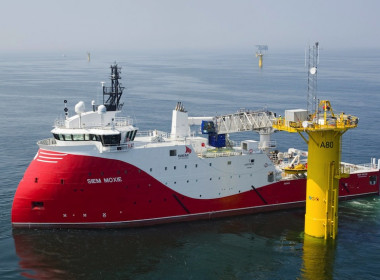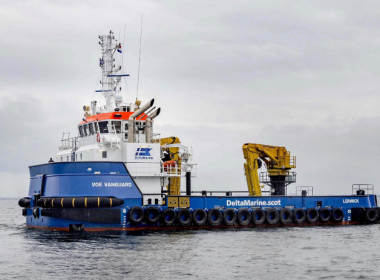COLUMN | Seacor Marine: will Charles Fabrikant take the business private? [Offshore Accounts]

After 28 years as a listed business, Seacor Holdings is being taken private. Last week, the directors of the American shipping company announced that they would be recommending a US$41.50 all cash takeover offer from the private equity firm American Industrial Partners, which values the business at the magical US$1 billion mark, with the buyers paying a 30 per cent premium on the previous 90-day average stock price. The shareholders will receive about US$845 million, and the balance is the company’s net debt of around US$155 million.
Executive chairman, CEO and founder Charles Fabrikant will step down, but his 34-year old son Erik will move up to the helm as CEO under the new owners, from his current role as COO. How Fabrikant junior will manage outside of a business run by his father remains to be seen. Mr Fabrikant senior is walking away from an annual pay packet of over US$3 million in 2019 (here), and will pocket an estimated US$22 million from the sale of his own half a million or so shares in the company as well, according to public records (here).
Offshore company Seacor Marine, not sold with Seacor Holdings
Seacor Marine, the offshore business, which owns over a hundred vessels servicing the oil and gas and wind markets, was not part of the deal. Seacor Marine was spun out of Seacor Holdings in 2017 and remains separately listed. At the time of the spin out, all the shares in Seacor Marine were distributed pro-rata to Seacor Holdings’ shareholders.
Mr Fabrikant also personally owns around 360,000 shares in that business too, and is the chairman; although at just over US$2 a share today, his stake is worth less than the price of two laid-up Bourbon Liberty-class PSVs in the French company’s recent online auction.
Helicopters spun off as well
Seacor Holdings had also spun out its Era Group helicopter business in 2013. Earlier this year Bristow and Era merged, although the reverse triangle merger gave legacy Bristow shareholders ownership of 77 per cent of the equity of the new company, and the legacy Era shareholders, including Mr Fabrikant, the remaining 23 per cent.
Stable, low-growth American businesses sold
American Industrial Partners’ decision to take Seacor Holdings private came after the company’s stock hit a 15-year low in April this year. Stripped of its offshore fleet and its helicopters by the spin-offs, Seacor Holdings has been a mixed bag of low-growth businesses, mainly focused in the US.
There’s the leftovers of the Seabulk business acquired for the same symbolic US$1 billion in 2005 – extensive harbour towage in the States, especially Florida, and the Caribbean, and some Jones Act tankers – also, a pair of aged American-flagged bulk carriers, a small oil spill response business, a fleet of eight vessels, mainly landing craft, serving the Bahamas, and a bunch of barges engaged in transporting commodities, such as salt, iron ore and steel, around the domestic waterways of the US.
Seacor Holdings itself owned 591 covered hopper barges at the end of 2019, chartered in another 50, and managed a pool with a further 491 third party-owned barges, plus various grain elevators and warehouses supporting the barge operations. The company also bareboats in four pure car and truck carriers working the Transpacific trade and serving the US military, operates a joint venture serving a rail ferry between the US and Mexico, and provides a Ro-Ro service between Florida and Puerto Rico.
There’s next to no synergy between the businesses, and many benefit from restrictive American laws preventing foreign companies operating in the domestic transportation sector.
Positive, but slender returns, limited capex at Seacor Holdings
With its low debt and focus on steady growth, Seacor Holdings generated steady cash flow and net profit of US$27 million last year. According to its annual report (here), the company’s capital commitments as of September 30, 2020 were just US$55 million and included four US-flagged harbour tugs, the company’s interest in two foreign-flag rail ferries, six inland river dry-cargo barges, one inland river towboat, some other equipment, and vessel and terminal improvements.
This is fundamentally a boring, stable business, which Mr Fabrikant had insulated from the volatile oil and gas cycle by spinning out the volatile offshore fleet and the helicopters. He calculated that Seacor Holdings earnt a return on equity of only 3.8 per cent in 2019 – small, but positive in an environment where all of its major erstwhile offshore competitors had entered Chapter Eleven, and where all the major helicopter companies, including Bristow and CHC, had also gone bust as well.
The future is debt and sweat
Seacor Holdings’ future is one of leverage and volatility, asset lives being extended, and the new private equity owners leaching the business for back office support fees and charges – that is what private equity does; the secret sauce is the leverage and Seacor Holdings today is a profoundly unleveraged business.
We can expect to see an explosion of debt and probably a massive “dividend recapitalisation” where Seacor Holdings borrows money and immediately pays out the cash to the new private equity owners in 2021. This, of course, increases the risk that the business will go bust in future, but after such a large pay out, the new owners at American Industrial Partners are unlikely to care.
The average age of the Seacor barge fleet is eleven years, so expect these assets to be sweated longer and harder, rather than being replaced. The same is true in the harbour towage business, where Mr Fabrikant admitted in the annual report that Seacor’s “oldest tugs are around 40 years old. In the last 10 years, we have sold 11 tugs that were over 25 years in age, and for over 55 per cent more than end-of-life book value.”
Such a prospect must be attractive to the new owners, even if it is deeply unattractive to the company’s customers, but the Jones Act limits their choices anyway.
By selling when he did, Mr Fabrikant secured a high multiple of Seacor’s future earnings for himself and the shareholders. The future problems are entirely foreseeable, but they are no longer his problem.
What to do with Seacor Marine?
The sale of Seacor Holdings raises the intriguing question: will Charles Fabrikant now take Seacor Marine and its fleet of lift boats, anchor handlers, supply vessels, and crewboats private as well, but under his own control, rather than that of an outside private equity company?
At the time of writing the equity of Seacor Marine was worth just US$50 million and the stock price had slumped to a record low since its separate listing. The company is loss-making as offshore struggles, but has successfully avoided bankruptcy so far. Oil returned back above US$50 a barrel last week and its third quarter results showed an uptick in utilisation and day rates (here).
In the third quarter to September 30, 2020, Seacor Marine lost US$11 million operationally, and paid another US$9 million of interest, to give a total net loss of US$20 million. Had Seacor Marine remained part of Seacor Holdings, it would have dragged the parent company into a loss. Many of its major competitors have gone through complete restructurings in the long industry downturn with their debt swapped for equity, including Tidewater, Bourbon, Hornbeck, and Solstad. As a result, Seacor Marine is weighed down by US$453 million of long-term debt, which it can service, but which is far higher than most of its restructured rivals, who are now nearly debt free.
Seacor Marine’s equity is worth pennies, and the stock trades well below net book value. Loss-making and unloved, Seacor Marine has modern vessels valued at US$743 million on its books, but total liabilities of US$623 million. Here lies the opportunity for Mr Fabrikant.
Seacor Marine’s differentiated strategy
In recent years Seacor has sought to differentiate itself from the rest of the offshore marine business, selling its aged Boston Putford fleet of North Sea standby boats, investing in new, battery-powered diesel-electric hybrid platform supply vessels (which we covered here), and buying a fleet of 14 liftboats and over 40 crewboats.
All this could be taken private for just twice what the private equity buyers paid Charles Fabrikant for his own interest in Seacor Holdings. He already has the vehicle, his family investment firm, Fabrikant International Corporation. Between 1992 and 2010, Business Insider reported (here) that Mr Fabrikant had compounded capital at a 15 per cent rate since 1992, when Seacor listed, compared to the S&P 500 index, which, delivered 5.6 per cent annual return over the same period.
Mr Fabrikant is also famous for his annual letter to shareholders which rivals Warren Buffet’s more famous missive for its sagacity and pithy insight. For thirty years, he has consistently been the smartest man in offshore, watching as his competitors imploded and went bust one by one, all the while growing Seacor steadily, spinning off the risky parts, and finally exiting now to private equity at a handsome multiple on earnings.
When opportunity knocks, don’t knock it
Mr Fabrikant once wrote that, “if opportunity knocks, we should open the door.” The buyout of Seacor Holdings now provides him with the time and money to return to Seacor Marine, take it private, and then list it again when market sentiment returns for offshore stocks.
Indeed, market interest in Cadeler and Scorpio Bulkers as investment opportunities in wind turbine installation (here) suggests a “green”, environmentally sustainability slant focused on the hybrid vessels, the potential of the liftboats to work on windfarm maintenance, and the use of the fast transfer vessels in wind operations in the North Sea would make a relisted, repackaged Seacor Marine very attractive to investors seeking “sustainability”. Now that even Ocean Installer is called Havfram, perhaps a new name might also be required?
Back to his roots
This is, after all, how he made his fortune. Seacor was founded by Mr Fabrikant in 1989 when he and a group of investors purchased the Nicor Marine fleet of Gulf of Mexico supply vessels from a utility company at the nadir of the worst industry downturn that had yet occurred. Market sentiment was wretched, the bayous of Louisiana were packed with laid up ships, and venerable industry names such as Zapata Gulf Marine and Gulf Fleet were bleeding money. Fabrikant said he adopted the new name Seacor for the Nicor vessels “primarily because it was less costly to paint over two letters than the entire name.”
His timing was perfect. In 1990 the recovery in offshore finally began, and industry leader Tidewater swung from a loss to a US$22 million profit. Fabrikant took Seacor public in 1992, and then embarked as the industry’s savviest consolidator, buying the Smit-Lloyd fleet of international anchor handlers, the Sterling fleet of North Sea vessels and the Boston Putford standby boat fleet, before he paid US$1 billion for Seabulk, an offshore player which had over expanded, and which had an attractive Jones Act cabotage tanker and harbour towing business, that became the mainstay of Seacor Holdings’ non-offshore businesses.
Do it, Charles; you know you want to
Seacor Marine in 2020 is what Nicor Marine was in 1989. It trades at a discount. It holds assets which have an inherent value which the market does not recognise. The industry is a bombed out hellscape, as it was in 1989. Here is an opportunity which Mr Fabrikant can and should take to buy the business with his own money, rather than leaving it languishing in the public markets. American Investment Partners has given him the firepower to double down on offshore at just the moment when the worst has passed and when assets are cheapest.
If Seacor Holdings can go private, Seacor Marine certainly should.
Background reading
The history of Seacor can be read here.
The account of Tidewater’s purchase of Zapata Gulf Marine is here.
The history of Tidewater is here.








